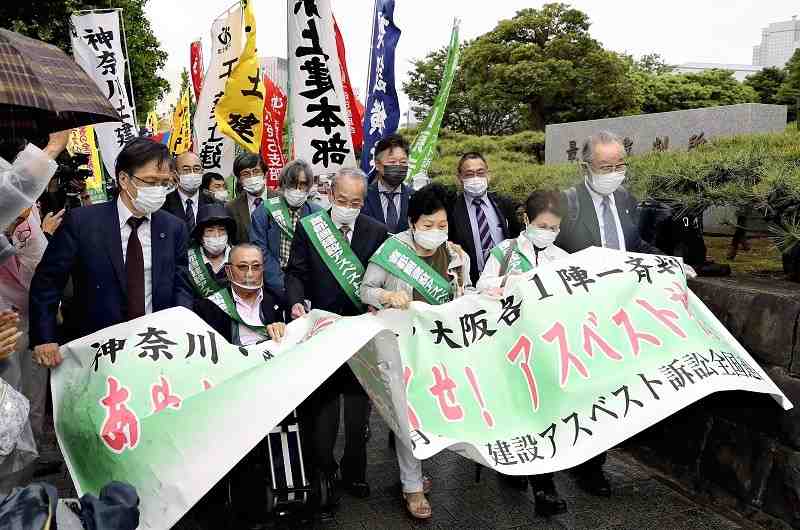
A group of plaintiffs in asbestos-related lawsuits enters the grounds of the Supreme Court in Chiyoda Ward, Tokyo, on Monday.
18:19 JST, October 18, 2021
A ruling party project team has been helping the government mediate settlement packages for the lawsuits filed years ago by former construction workers over asbestos-related damage to their health, even before the Supreme Court’s recent ruling.
The top court ruled on Monday that the government and construction materials makers are liable to pay damages in four class action lawsuits.
The latest package compiled by the project team, however, does not include the manufacturers, meaning problems remain before the issue can be settled completely.
A step forward
According to the Health, Labor and Welfare Ministry, there have been 33 cases filed against the central government, bringing the total number of plaintiffs to more than 1,000.
While the trials have been ongoing, many plaintiffs have died from diseases such as mesothelioma and lung cancer that developed after exposure to asbestos.
Before the Supreme Court made its ruling Monday, the top court took the unusual step between December 2020 and February this year of rejecting the final appeals of some of the class action lawsuits by determining that liability rests with the central government and some manufacturers. The move was made to prioritize early payment of damages to victims and bereaved families.
“We’ve moved a step forward,” a 78-year-old plaintiff in an ongoing trial at the Sendai District Court said Monday. “Considering our age, we won’t be able to endure trials that continue without end.”
Regarding the settlement package compiled by the project team, he said, “I want to see a compensation system for those who have not filed a lawsuit, too.”
In May 2008, former construction workers, many of whom had contributed to Japan’s rapid economic growth, filed the first class action lawsuit claiming asbestos-caused damage to their health at the Tokyo District Court. Since that time, similar lawsuits have been filed in various parts of the country.
As the trials have been conducted separately, lower courts have been divided over such key issues as the period for which the central government should be held responsible and whether to include independent contractors in the scope of the relief.
Responsibility ratio
In line with the Supreme Court’s December-February moves, the ruling parties launched the project team in February, trying to speed up the process after taking into account the progression of disease among victims and their increasing age.
“It’s not good to procrastinate,” said a senior Liberal Democratic Party official, having in mind the House of Representatives election scheduled to be held by this autumn.
One of the major agenda issues when drawing up the settlement plan was how the government and construction material makers would share responsibility. The plaintiffs had demanded that the state share half the responsibility, but many lower court rulings set it at one-third.
The project team decided to refer to the ruling regarding asbestos-related factories in the Sennan district of Osaka Prefecture that said the government held half the responsibility. A senior team member said the team concluded that the liabilities “shouldn’t be lower than what was decided in the Sennan case.”
The project team assessed that each victim can demand damages from the central government and the manufacturers of up to ¥26 million, in line with the compensation sought in the Sennan case, so it decided that the government will pay up to ¥13 million as a settlement that includes a delinquency charge.
Manufacturers’ opposition
However, this settlement package has not yet included the construction materials makers. This is because there are many asbestos-related materials manufacturers, with workers having been at various construction sites, making it difficult to determine which materials were used at which site.
According to sources, the project team on Friday sought opinions from the manufacturers on the settlement package, but they were reluctant to participate. As a result, lawsuits against manufacturers may continue. The project team will continue to discuss the responsibility of manufacturers.
Hirotada Hirose, a professor emeritus at Tokyo Woman’s Christian University who warned of the use of asbestos in 1985, calling it a “quiet time bomb,” said: “Based on the Supreme Court ruling, the government should review why it failed to prevent the damage from spreading. It should also get manufacturers involved and quickly come up with settlement packages that cover victims beyond the plaintiffs, too.”
Non-plaintiff payments
Asbestos-caused diseases such as mesothelioma have long incubation periods, sometimes developing several decades later.
The project team plans to create a separate settlement package to help victims who are not plaintiffs, in anticipation that more victims will appear. The government aims to submit a related bill to the current Diet session.
Under the envisioned plan, victims and their families can file a claim with the health ministry, which screens the claims. The payment is expected to be up to ¥13 million, the same amount as the damages for plaintiffs.
About 70% of the plaintiffs have already died. These former construction workers and other plaintiffs have appealed for out-of-court settlements, claiming that it was unjust to impose the burden of lengthy trials. The project team heard such complaints, with a senior team member saying, “All we can do is speed up relief and reduce the burden on victims.”
This type of settlement was adopted in the past for asthma sufferers in Tokyo, who filed lawsuits against the central government and manufacturers in the so-called Tokyo air pollution suit, claiming that vehicle emissions caused health problems. At that time, the central and Tokyo metropolitan governments and manufacturers that accepted the court’s advice to compromise established a medical expense subsidy system. For claimants to qualify for the subsidy, they are screened by a panel of doctors and others at a public health center.
Regarding people who became infected with hepatitis C through contaminated blood products, lawmaker-initiated legislation was enacted in 2008 to provide relief and set up a fund to be borne by the central government and pharmaceutical companies in the Pharmaceuticals and Medical Devices Agency. In this case, victims have to file a suit against the government to get compensation.
“There were opinions that undergoing a judicial process would lead to fairness and satisfaction for the victims,” said a government official in charge of the matter.
"Society" POPULAR ARTICLE
-

M4.9 Earthquake Hits Tokyo, Neighboring Prefectures
-

Israeli Tourists Refused Accommodation at Hotel in Japan’s Nagano Pref., Prompting Protest by Israeli Embassy and Probe by Prefecture
-

M7.5 Earthquake Hits Northern Japan; Tsunami Waves Observed in Hokkaido, Aomori and Iwate Prefectures
-

Tsukiji Market Urges Tourists to Avoid Visiting in Year-End
-

High School in Kyoto Says Students Shoplifted during Recent School Trip to Bali, Indonesia
JN ACCESS RANKING
-

Tokyo Economic Security Forum to Hold Inaugural Meeting Amid Tense Global Environment
-

Keidanren Chairman Yoshinobu Tsutsui Visits Kashiwazaki-Kariwa Nuclear Power Plant; Inspects New Emergency Safety System
-

Imports of Rare Earths from China Facing Delays, May Be Caused by Deterioration of Japan-China Relations
-

University of Tokyo Professor Discusses Japanese Economic Security in Interview Ahead of Forum
-

Japan Pulls out of Vietnam Nuclear Project, Complicating Hanoi’s Power Plans

























